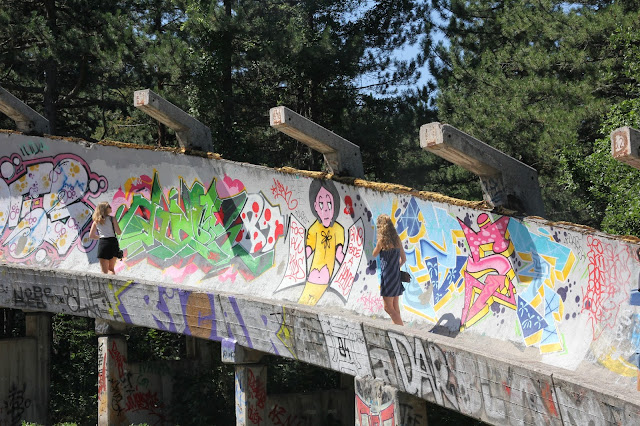The Bosnia File (post 2)
“This is the Sarajevo spirit where Muslims, Catholics, Orthodox Christians and Jews have been living together for centuries, exchanging culture and maintaining their own traditions, a people with no intention of dividing under the deadly pressure of ethnic cleansing, that truly want to live together, there, in the city of minarets, Eastern Orthodox churches, cathedrals and synagogues, in the heart of europe, at the intersection of East and West.”
Manuela Gandini (Absolut Sarajevo, Milan, 1995).
We followed the tank tracks along an overgrown section of roadway on the hills above the city of Sarajevo. The bobsled and luge runs from the 1984 Winter Olympics stood behind us as a rampart of the former glory of sport and celebration. The graffiti is all that adorns the cement structure now, but it was less than a generation ago that they were used as a defensive line in the battle for Sarajevo. We exited the vehicle and walked along a few pathways, inspecting bunkers leftover from the conflict.
 |
| Bobsled Track |
 |
| Rampart behind luge track |
"Bosnia had over 3 million landmines placed during the war."
The crack of branches underfoot made us a little nervous as we followed our guide around the hilltop. Our guide, who went by the name, “0-1,” which was his father’s code name during the siege of Sarajevo, was showing us the frontlines of a city that suffered the longest siege in modern times. Some anti-personnel mines when triggered pop out of the ground about 1 metre before exploding, while others explode omni-directional. The creativity of humanity knows no bounds.
 |
| Not a good idea to hike further |
We stood on the ridge overlooking the city as “0-1” told us of the valiant efforts of citizens of Sarajevo to counter the Siege. The intense shelling drove some citizens to launch impossible counter offensives up a 50 degree slope. (All 32 men died in that offensive.) Sniper’s would lay in their nests above the city picking off anything that moved below. In the city streets, handmade signs would warn of sniper danger zones, the crossing of which would be a serious gamble. What drove this city to such a precipice?
 |
| Graffiti from the war (painted on war hostel wall) |
 |
| Sentiment from the war |
 |
| The flag of countries in the peacekeeping effort |
There are many lenses from which to observe the conflict in Bosnia-Herzegovina. The foundation of the divisiveness is religious and ethnic. Ratko Mladic, the leader of the Bosnian Serbs, in a speech to rally the troops said: “We own this country, this is our country. Turks have been occupier.” The folk songs of the Serbs speak of a people who defended the Western world against an invading Muslim force (Ottomans) in the 13th Century. The Bosnian Serbs loaded their cannons of war with a strong conviction that they were righting the wrong inflicted upon their land so many centuries before.

As I sipped a Turkish Coffee in a cafe in Sarajevo I looked up to those same hills and thought how the people survived during these times. Back in the Fall of 1995 artists knew that Sarajevans needed some semblance of normalcy in the madness. They saw film as a way of expression and introspection, of levity and wonder. The Sarajevo film festival was born and continues on to this day.
The newspaper, Oslobodenje, continued to write and even though their offices had no heating in the cold winters they only missed one day of publishing in the nearly four year siege. The TV station continued to put out programs of not only information but also comedy. In a word, what kept the city going was persistence.
As in the city of Mostar, Sarajevans were mostly united. There were citizens of Serb background who stayed in their neighborhood with Bosniaks (Muslims) to fight the invaders even though they would have been granted safe passage out. They were committed to their community. This makes one ask the questions: “What is ethnicity?” and “What creates division among us?”
As I took the last sip of the coffee I saw several Muslim girls walk by. Some wore headscarves and others did not, yet there was a kinship among them. They were laughing and sharing jokes; one could sense the togetherness and love they had for each other. I recalled my conversation with the curator in the museum in Mostar. She wore a t-shirt and ripped jeans and she was proud to be a muslim. In the diversity there can be togetherness.
That is the key: togetherness. When a community focuses on what brings them together: the economic bonds, the ties to the land, the celebration of events where all are made to feel welcome, then it has a chance to not simply survive. It is a place of being alive and well. It is home.
As I left Sarajevo on the overnight bus I was filled with wonder at the country of Bosnia-Herzegovina. It is a country of paradox, of beauty and potential. Yet below the surface there is an itch that cannot seem to be scratched. The divisions continue, promoted by politicians greedy for power, knowing that they can win votes through ethnic related campaigning. In spite of this there is hope.
Let us hear the voice of Mehmed Alic who testified before the International Criminal Court when he noted that before 1992 we “had brotherhood and unity.” Is not love not a stronger force than hatred?

Comments